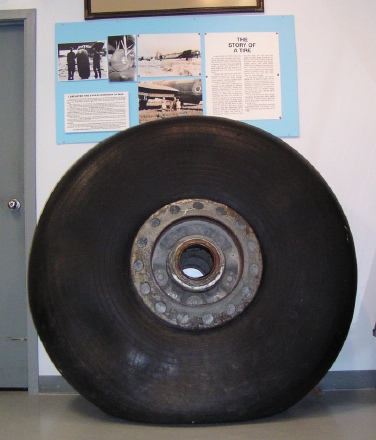 Museum
Museum  |
Bomber Command
|
Aircrew Chronicles
|
Aircrew Losses
|
Nose Art
|
BCATP
|
Lancaster
|
Media
|
Bomber Command
|
Aircrew Chronicles
|
Aircrew Losses
|
Nose Art
|
BCATP
|
Lancaster
|
Media
 Museum
Museum  |
Bomber Command
|
Aircrew Chronicles
|
Aircrew Losses
|
Nose Art
|
BCATP
|
Lancaster
|
Media
|
Bomber Command
|
Aircrew Chronicles
|
Aircrew Losses
|
Nose Art
|
BCATP
|
Lancaster
|
Media
Bomber Command Museum Chronicles
|
And thirty of them came after hair-raising missions deep into Europe and into Germany in particular. Bill Collins is one of the lucky ones and he knows it. A commemorative book at the Nanton Lancaster Museum lists the thousands of RCAF flyers who simply weren't so lucky. |
|
And not that he needs any further reminding of how Lady Luck smiled on him and amazingly on the rest of his crew between 1943 and 1945, he runs his fingers over one name in the book in particular, that of Richard Charles Collins, a 20-year-old flying officer/bomb aimer, missing presumed killed March 22, 1944.
That was Collins's brother - and he'll never forget his mother got the dreaded message of her other's son's death on her birthday.
And not that he needs any further reminding . . . he runs his 78-year-old fingers, frail now but lightning fast then, over the strangely smooth puck-hard rubber of a metre-high tire leaning against the museum wall.
This is it.
All that remains Canadian-built Lancaster KB773, call sign P for Peter, of 431 (Iroquois) Squadron 6 Bomber Group based in Croft, Yorkshire, England.
Happy landings indeed on this very tire that was the left landing gear under the massive wing of a very lucky aircraft capable of carrying the biggest payload of any World War Two bomber.
The old-timer from Montreal, an alternating tail gunner - "Tail End Charlie" - and mid-upper gunner aboard P for Peter on numerous hair-raising night and day raids seems to stroke the tire.
"Many's the time we got out of that plane in England and we kissed this very tire, or kicked it, or heck, even just kissed the ground," says the diminutive man with a shock of silver hair.
Like others of his kind, he underplays his part.
But he remembers particularly his first and last missions on KB773.
"The first I was just a kid, 18-years-old in 1943. I remember being so excited. Not nervous at all. Hell, we didn't know what it was going to be like," says the man whose pilot was Bill Dowbiggin, dad of Herald columnist Bruce, it turns out strangely.
Then the flak started coming up at them, then the fighters started swooping down on them from above firing fast as they came and then banking up or down away in case they actually hit the Lanc with its bomb load.
"If they hit us while we had our bombs on board, they would have gone up with us . . ." says Collins.
The second mission he was nervous . . . and the third, and the fourth . . .
"We knew what to expect then and it got worse all the time. The flak got worse the deeper into Germany we had to go, and then the first jet fighters arrived. I remember sitting in the tail one day and watched seven Messerschmitt 262s, twin-engined things, coming in. We hadn't a clue what they were, they hadn't told us about them, or didn't know about them.
"And they selected a target and picked off seven Lancs from the flight behind us. . . the cannons they had, so powerful . . . the bombers, big as they were, just kinda disappeared."
And the fifth . . . and the sixth . . . and the seventh . . . on and on his war went.
Somewhere in there was the time a 400 pound bomb didn't release from the aircraft's bomb bay and no matter how hard the pilot wiggled, waggled, dived, climbed and turned to shake it loose they had to land with it on board.
 KB-773's tire on display in the museum. |
"I remember telling Bill on the intercom 'this better be your best landing' . . . and it turned out to be his worst. We hit with a bang, but somehow that bomb stayed in its rigging, didn't even drop onto the bomb bay doors . . . " There was plenty of kissing tires and ground that day. And the 28th, and the 29th and . . . "The last one was the one I have worried most about. Still do. I've never been comfortable with it. We carried nothing but incendiaries and we were part of one of the thousand bomber raids. The Target was Dresden. It wasn't a military target . . . it was just people that were bombed." Dresden all but disappeared in a firestorm. He seems to shudder even now at the thought. But he rubs that lucky tire again. |